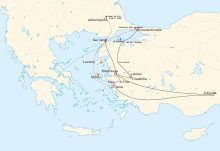You can help expand this article with text translated from the corresponding article in Italian. (July 2020) Click [show] for important translation instructions.
|
| Catalan Campaign in Asia Minor | |||||||
|---|---|---|---|---|---|---|---|
 | |||||||
| |||||||
| Belligerents | |||||||
|
Catalan Company (until 1305)[1] |
Various Anatolian Turkish Beyliks Catalan Company (after 1305)[1] | ||||||
| Commanders and leaders | |||||||
|
Roger de Flor (before 1305) |
Roger de Flor X (1305) Berenguer d'Entença | ||||||
| Strength | |||||||
| 10,900 in total (see "strength of forces") | 30,000 men, according to Ramon Muntaner | ||||||
| Casualties and losses | |||||||
| Only about 1,500 Catalans remained, according to Ramon Muntaner | 18,000 supposedly lay dead, according to Ramon Muntaner | ||||||
In 1303, the Byzantine Emperor Andronicus II Palaeologus hired 6,500 Catalan mercenaries under Roger de Flor[2] to campaign against the Turks in the spring and summer of the same year. Their costly service came with success, driving back the Turks in parts of Asia Minor.[3] At Philadelphia, 18,000 Turkish soldiers (possibly those of Aydinids) were left dead, the work of the Catalans.
However, the Byzantines got more than what they bargained for; the mercenaries were difficult to restrain and consequently much of the reconquered territory was laid to waste. When their leader Roger de Flor was assassinated in Gallipoli on 3 April 1305 by Michael IX Palaeologus followed by a massacre of 1,300 Catalans,[2] the mercenaries began a two-year pillage in revenge and crossed over to Thrace and Macedonia under the command of their new leader, Berenguer d'Entença,[3] where further raiding occurred. As a result of this brutality, the Company was excommunicated by Pope Clement V.[3] Eventually the Catalan mercenaries claimed the Duchy of Athens for themselves in 1311 and would remain there until 1379,[3] leaving behind a devastated Byzantium. After this, the Turks found much support amongst those who suffered and reoccupied land that had been lost.
Thus, the Catalans' campaign was a short-term Byzantine victory, but benefited the Turks in the long term.
- ^ a b Ágoston, Gábor; Masters, Bruce Alan (2009). Encyclopedia of the Ottoman Empire. Infobase Publishing. p. 232. ISBN 9781438110257.
- ^ a b Cite error: The named reference
cataloniawas invoked but never defined (see the help page). - ^ a b c d Rogers, Clifford (2010). The Oxford Encyclopedia of Medieval Warfare and Military Technology. Oxford University Press. p. 350. ISBN 9780195334036.